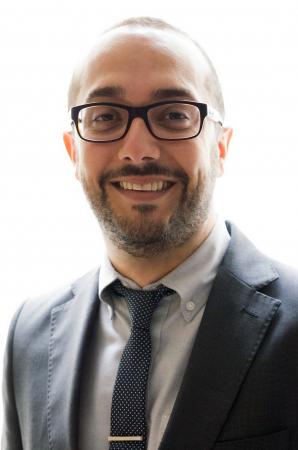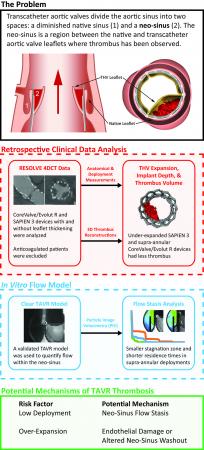A diagnosis of aortic stenosis – narrowing of the aortic valve opening – is one of the last things any patient wants to hear. Left untreated, the outlook is dire. The most common treatment is open heart surgery, in which a surgeon replaces the diseased valve with a man-made mechanical valve, or a biological valve made of animal tissue.
But for medically fragile patients, invasive open-heart surgery may be too risky. Until fairly recently, these people faced long odds. That changed with the introduction of transcatheter aortic valve replacement (TAVR), a procedure that became available in the U.S. in 2011, for people with limited choices for life-saving valve repair.
Minimally-invasive TAVR delivers a replacement valve through a catheter – no need to surgically open the chest. It’s proven to be an effective procedure, buying precious years and improving quality of life for patients who have run out of options. But it can be better. Research in the past two years reports the formation of prosthetic valve leaflet thrombosis (blood clotting), a condition which is potentially life-threatening and may cause the replacement valve to deteriorate prematurely.
A recent multi-institutional study published in the journal Circulation, led by researchers in the Petit Institute for Bioengineering and Bioscience and Wallace H. Coulter Department of Biomedical Engineering, is the first to provide a mechanistic insight into transcatheter valve thrombosis. And the research is impactful enough to stand out in a crowded field, becoming the subject for a glowing editorial in the same October edition of the journal.
“That was quite a good response to our work, and it validates the need for more studies like this, looking at the fluid mechanics of these valves,” says Ajit Yoganathan, Regents’ professor and associate chair for translational research in the Coulter Department (a joint department of Georgia Tech and Emory University), and senior author of the research, entitled, “Fluid Mechanics of Transcatheter Heart Valve Leaflet Thrombosis in the Neosinus.”
“The data shows that despite the short-term success of these valves, there can be problems, so the situation needs to be studied if we want to further the field and improve patient outcomes,” adds Yoganathan, a founding member of the Petit Institute, and principle investigator of the Cardiovascular Fluid Mechanics Lab, which he started almost 40 years ago.
Guiding the Next Generation
Yoganathan and the paper’s lead author, Prem Midha (who recently earned his Ph.D. in Yoganathan’s lab) believe the research can help guide the development of improved next-generation devices with reduced thrombosis risk. The authors of the Circulation editorial are on the same page, writing, “Such information may help select specific valve types tailored to different anatomies, and also help modify future devices.”
The researchers also took heart from the bylines on the editorial – “They got some real heavyweights from a strong group,” Yoganathan says. The three MDs who wrote the editorial – Samir Kapadia, E. Murat Tuzcu, and Lars G. Svensson – are affiliated with the Cleveland Clinic.
The researchers used 4-dimensional CAT scan data from TAVR patients who are enrolled in the RESOLVE clinical trial registry, focusing on people who are using one of two different transcatheter heart valves – one from Edwards Lifesciences, the other from Medtronic.
Their aim was to identify and evaluate risk factors that contribute to transcatheter heart valve (THV) thrombosis through the combination of retrospective clinical data analysis and in vitro imaging of the space that is formed following deployment of a transcatheter valve into a native aortic valve. They identified this space, called the neosinus, as a critical region in THV thrombosis.
They explored the in vitro effect of valve position and geometry – how the valve was implanted, how it interacts with a given patient’s anatomy. “There are different valve design types and patient anatomies vary, so we were interested to know how a valve’s design interacts with one person’s anatomy versus another person’s,” Yoganathan says.
They suggest ways in which future designs and clinical practice may be improved, concluding that additional clinical and in vitro studies are needed. The editorial writers think that is all but inevitable, writing, “the authors should be congratulated for an important hypothesis-generating article. This study will undoubtedly stimulate further clinical research to understand the clinical implications of these interesting observations.”
“This was a completely independent study,” says Yoganathan, in that there was no industry support for the research paper, which carries 11 authors’ names. In addition to Yoganathan and Midha, the multi-institutional team included: Vrishank Raghav and Ikechukwu Okafor from Georgia Tech; Jose Condado, Gautam Kumar, Vinod Thourani, and Vasilis Babaliaros from Emory University; Rahul Sharma, Tanya Rami, and Raj Makkar from Cedars-Sinai Heart Institute (Los Angeles), and Hasan Jilaihawi from New York University’s Langone Medical Center.
Yoganathan says the goal is for transcatheter heart valves to be comparable to surgically-implanted valves, “to match their performance and longevity, which makes this kind of research exciting as we move forward. We need to be looking at this as a community to ensure the long-term success of these devices.”
Media Contact
Jerry Grillo
Communications Officer II
Parker H. Petit Institute for
Bioengineering and Bioscience
Keywords
Latest BME News
Jo honored for his impact on science and mentorship
The department rises to the top in biomedical engineering programs for undergraduate education.
Commercialization program in Coulter BME announces project teams who will receive support to get their research to market.
Courses in the Wallace H. Coulter Department of Biomedical Engineering are being reformatted to incorporate AI and machine learning so students are prepared for a data-driven biotech sector.
Influenced by her mother's journey in engineering, Sriya Surapaneni hopes to inspire other young women in the field.
Coulter BME Professor Earns Tenure, Eyes Future of Innovation in Health and Medicine
The grant will fund the development of cutting-edge technology that could detect colorectal cancer through a simple breath test
The surgical support device landed Coulter BME its 4th consecutive win for the College of Engineering competition.










